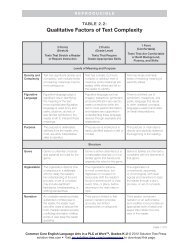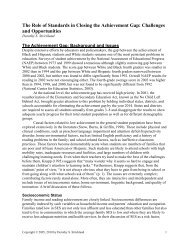Global Education Digest 2012 - International Reading Association
Global Education Digest 2012 - International Reading Association
Global Education Digest 2012 - International Reading Association
Create successful ePaper yourself
Turn your PDF publications into a flip-book with our unique Google optimized e-Paper software.
OPPORTUNITIES LOST: THE IMPACT OF GRADE REPETITION AND EARLY SCHOOL LEAVING<br />
Percentage of technical and vocational enrolment. Total number of pupils or students enrolled in technical<br />
and vocational programmes at a given level of education, expressed as a percentage of the total number of<br />
pupils or students enrolled in all programmes (technical/vocational and general) at that level.<br />
Percentage of trained teachers. Total number of teachers who have received the minimum organised teachertraining<br />
(pre-service or in service) required for teaching at the relevant level of education in a given country,<br />
expressed as a percentage of the total number of teachers at the given level of education.<br />
Pupil/teacher ratio. The average number of pupils per teacher at a given level of education, based on<br />
headcounts of both pupils and teachers.<br />
Purchasing power parity (PPP). The currency exchange rates that equalise the purchasing power of different<br />
currencies. This means that a given sum of money, when converted into U.S. dollars at the PPP exchange rate<br />
(PPP dollars), will buy the same basket of goods and services in all countries. In other words, PPPs are the<br />
rates of currency conversion which eliminate the differences in price levels among countries. Thus, comparisons<br />
between countries reflect only differences in the volume of goods and services purchased.<br />
Regional average. Weighted averages for a region, taking into account the relative size of the relevant<br />
population of each country. The figures for countries with larger populations thus have a proportionately greater<br />
influence on the regional aggregates. The averages are derived from published data complemented by imputed<br />
values for missing countries. Imputations are based on publishable data for the same countries from previous<br />
and/ or following years. When imputing an indicator, information from related indicators is used to strengthen the<br />
imputation hypothesis.<br />
Repeater. Pupil enrolled in the same grade for a second or further year.<br />
School-age population. Population of the age group theoretically corresponding to a given level of education,<br />
as indicated by theoretical entrance age and duration.<br />
School life expectancy. The number of years a person of school entrance age can expect to spend within the<br />
specified level of education. It is the sum of age-specific enrolment rates expressed as a percentage divided by<br />
100, for the levels of education specified. Enrolment that is not distributed by age is divided by the school-age<br />
population and multiplied by the duration of the given level before being added to the sum of the age-specific<br />
enrolment rates.<br />
School life expectancy net of repetition. The expected number of years of schooling that a child of school<br />
entrance age can expect to spend within the specified level of education, excluding years spent repeating a<br />
grade. It estimates the number of grades of schooling on average that a child will complete in his or her lifetime.<br />
Students<br />
Student/pupil. Pupil refers to a child enrolled in a basic educational programme; while pupils are always<br />
considered to be students, children, youth or adults enrolled at more advanced levels of education are<br />
more commonly referred to as students, and less often as pupils.<br />
Full-time students. Students engaged in an educational programme for a number of hours of study<br />
statutorily regarded as full-time at a particular level of education in a given country.<br />
69

















